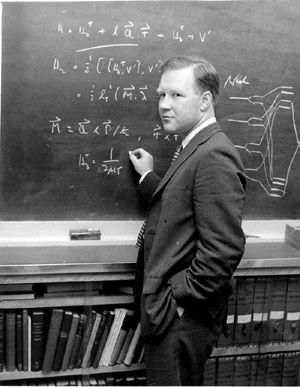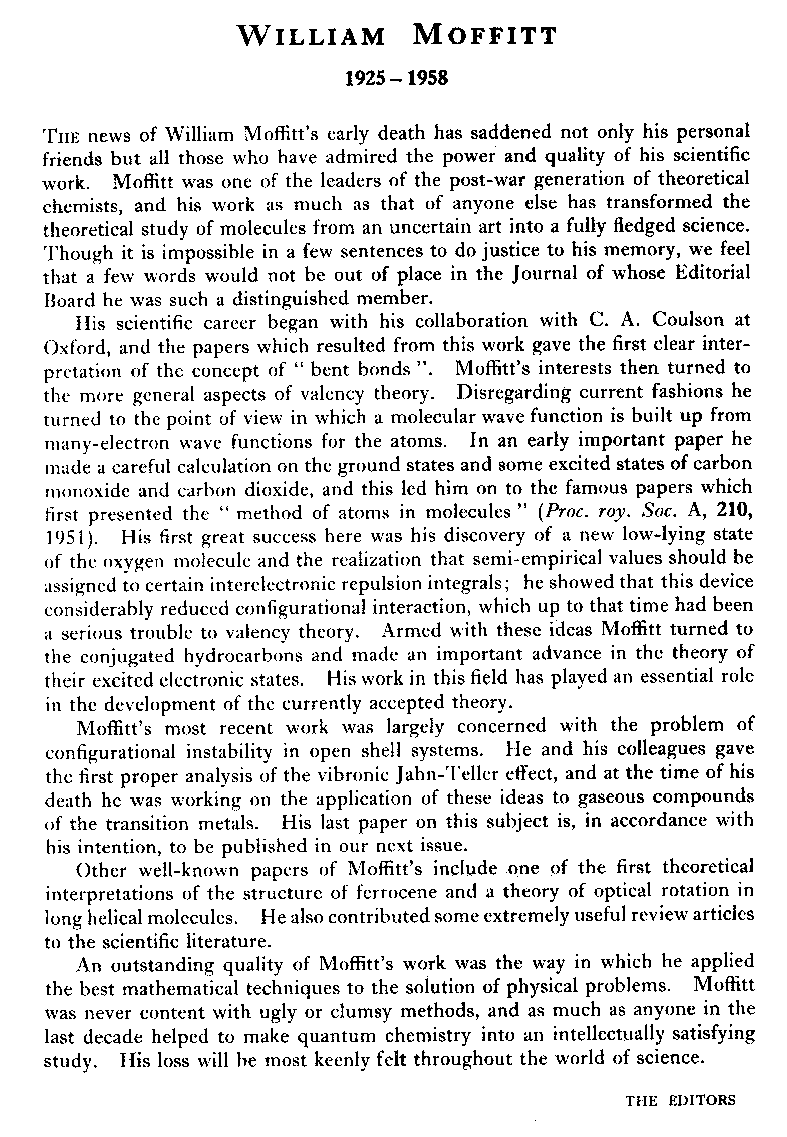 Click to enlarge
Click to enlarge
William Moffitt
Photo courtesy and
©
Dorothy Moffitt Altman (William's widow)
Alison Moffitt Altman (William's daughter)
Susan Altman (half-sister of Alison and daughter of Dorothy)
|
|
WILLIAM MOFFITT
1925—1958
The news of William Moffitt's early death has saddened not only his personal
friends but all those who have admired the power and quality of his scientific
work. Moffitt was one of the leaders of the post-war generation of theoretical
chemists, and his work as much as that of anyone else has transformed the
theoretical study of molecules from an uncertain art into a fully fledged science.
Though it is impossible in a few sentences to do justice to his memory, we feel
that a few words would not be nut of place in the Journal of whose Editorial
Board he was such a distinguished member.
His scientific career began with his collaboration with C. A. Coulson at
Oxford, and the papers which resulted from this work gave the first clear inter-
pretation of the concept of 'bent bonds'. Moffitt's interests then turned to
the more general aspects of valency theory. Disregarding current fashions he
turned to the point of view in which a molecular wave function is built up from
many-electron wave functions for the atoms. In an early important paper he
made a careful calculation on the ground states and some excited states of carbon
monoxide and carbon dioxide, and this led him on to the famous papers which
first presented the 'method of atoms in molecules' (Proc. Roy. Soc. A 210,
1951). His first great success here was his discovery of a new low-lying state
of the oxygen molecule and the realization that semi-empirical values should be
assigned to certain interelectronic repulsion integrals; he showed that this device
considerably reduced configurational interaction, which up to that time had been
serious trouble to valency theory. Armed with these ideas Moffitt turned to
the conjugated hydrocarbons and made an important advance in the theory of
their excited electronic states. His work in this field has played an essential role
in the development of the currently accepted theory.
Moffitt's most recent work was largely concerned with the problem of
configurational instability in open shell systems. He and his colleagues gave
the first proper analysis of the vibronic Jahn-Teller effect, and at the time of his
death he was working on the application of these ideas to gaseous compounds
of the transition metals. His last paper on this subject is, in accordance with
his intention, to be published in our next issue.
Other well-known papers of Moffitt's include one of the first theoretical
interpretations of the structure of ferrocene and a theory of optical rotation in
long helical molecules. He also contributed some extremely useful review articles
to the scientific literature.
An outstanding quality of Moffitt's work was the way in which he applied
the best mathematical techniques to the solution of physical problems. Moffitt
was never content with ugly or clumsy methods, and as much as anyone in the
last decade helped to make quantum chemistry into an intellectually satisfying
study. His loss will be most keenly felt throughout the world of science.
THE EDITORS
Sorry - but this website has presently honestly
lost the source (loose sheet).
|




